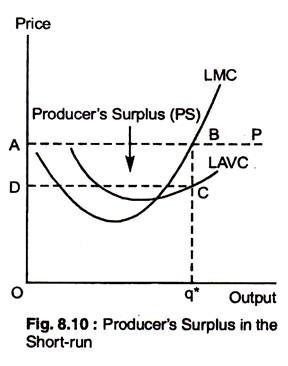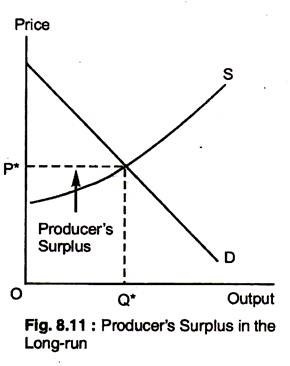Let us make an in-depth study of the producer’s surplus in the short-run for a firm.
The producer’s surplus of a firm is the sum over all units of production of the difference between the market price and the MC of production.
Thus, just as the consumer’s surplus measures the area below the demand curve of an individual and above the market price, producer’s surplus measures the area above a producer’s supply curve and below the market price.
Fig. 8.10 illustrates the producer’s surplus for a firm. The profit-maximising output is q*, where P – MC. Producer’s surplus is given by the area ABCD — under the demand curve and above the MC curve, from zero output to the profit-maximizing output q*.
ADVERTISEMENTS:
Alternatively, it can be defined as the difference between the firm’s revenue and its total variable costs (TVC) which is represented by the area ABCD = Revenue OABq* – Variable Cost (ODCq*).
Producer’s surplus is related to profit, but is not equal to it. Producer’s surplus subtracts only variable costs from revenues, while profit subtracts both variable and fixed costs. PS = TR – TVC and Profit – π-TR- TVC – TFC. Thus, producer’s surplus is always greater than profit.
The extent to which firms enjoy PS depends on their costs of production. Higher-cost firms have less PS than low-cost firms. By adding up all the individual firm’s producer’s surplus, we can find the PS for a market. In Fig. 8.11, the market PS is obtained by the area below the market price and above the market supply curve, between O and output Q*.

